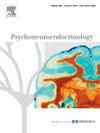早期生活压力对网络和行为状态的影响
IF 3.6
2区 医学
Q2 ENDOCRINOLOGY & METABOLISM
引用次数: 0
摘要
童年不良经历(ace)与许多健康损害有关,包括对精神疾病的易感性增加。啮齿动物的早期生活压力(ELS)已被证明可以有效地模拟ace的几种行为和内分泌影响,并已被用于研究导致疾病的潜在机制。然而,负责调节ELS对精神疾病易感性影响的精确神经机制在很大程度上仍然未知。方法采用行为学、免疫分析、体内局部场电位(LFP)记录、组织学和膜片钳等方法,研究ELS对雌雄小鼠应激相关行为、内分泌变化、网络状态、蛋白表达和细胞生理的影响。我们证明了小鼠母性分离(MS) ELS模型在急性应激源后引起雄性特异性行为和激素反应的改变。基底外侧杏仁核(BLA)和额叶皮质(FC)的LFP记录显示,在基线和对急性行为学应激的反应中,存在类似的性别特异性改变。此外,雄性BLA主神经元和雌性BLA小白蛋白(PV)中间神经元的生理变化表明,这些作用可能是通过一种可能的机制介导的。这些发现支持了大量的文献,证明这些网络状态有助于压力反应和对精神疾病的脆弱性。总的来说,这些结果暗示了ace可能影响精神健康的独特的、新颖的男性和女性特异性机制,包括参与情绪处理的细胞生理和网络状态的改变。本文章由计算机程序翻译,如有差异,请以英文原文为准。
Effects of early life stress on network and behavioral states
Background
Adverse childhood experiences (ACEs) are associated with numerous detriments in health, including increased vulnerability to psychiatric illnesses. Early life stress (ELS) in rodents has been shown to effectively model several of the behavioral and endocrine impacts of ACEs and has been utilized to investigate the underlying mechanisms contributing to disease. However, the precise neural mechanisms responsible for mediating the impact of ELS on vulnerability to psychiatric illnesses remain largely unknown.
Methods
We use behavior, immunoassay, in vivo local field potential (LFP) recording, histology, and patch clamp to describe the effects of ELS on stress-related behaviors, endocrine changes, network states, protein expression, and cellular physiology in male and female mice.
Results
We demonstrate that a murine maternal separation (MS) ELS model causes male-specific alterations in behavioral and hormonal responses following an acute stressor. LFP recordings in the basolateral amygdala (BLA) and frontal cortex (FC) reveal similar sex-specific alterations at baseline and in response to acute ethological stress. Furthermore, altered physiology of BLA principal neurons in males and BLA parvalbumin (PV) interneurons in females suggests a likely mechanism through which these effects may be mediated. These findings support a large body of literature demonstrating that these network states contribute to stress reactivity and vulnerability to psychiatric illnesses.
Conclusions
Collectively, these results implicate distinct, novel male- and female-specific mechanisms through which ACEs may impact psychiatric health, including altered cellular physiology and network states involved in emotional processing.
求助全文
通过发布文献求助,成功后即可免费获取论文全文。
去求助
来源期刊

Psychoneuroendocrinology
医学-精神病学
CiteScore
7.40
自引率
8.10%
发文量
268
审稿时长
66 days
期刊介绍:
Psychoneuroendocrinology publishes papers dealing with the interrelated disciplines of psychology, neurobiology, endocrinology, immunology, neurology, and psychiatry, with an emphasis on multidisciplinary studies aiming at integrating these disciplines in terms of either basic research or clinical implications. One of the main goals is to understand how a variety of psychobiological factors interact in the expression of the stress response as it relates to the development and/or maintenance of neuropsychiatric illnesses.
 求助内容:
求助内容: 应助结果提醒方式:
应助结果提醒方式:


